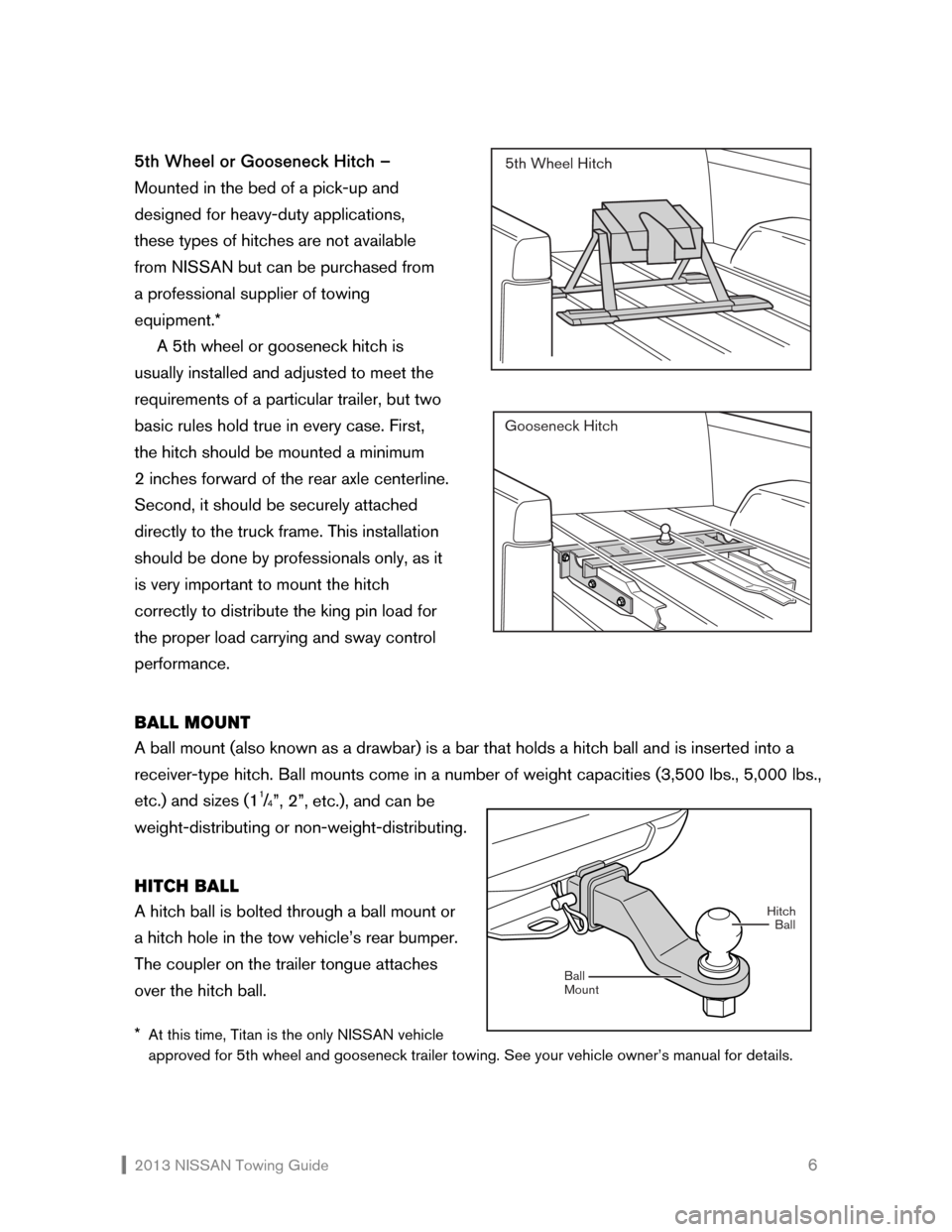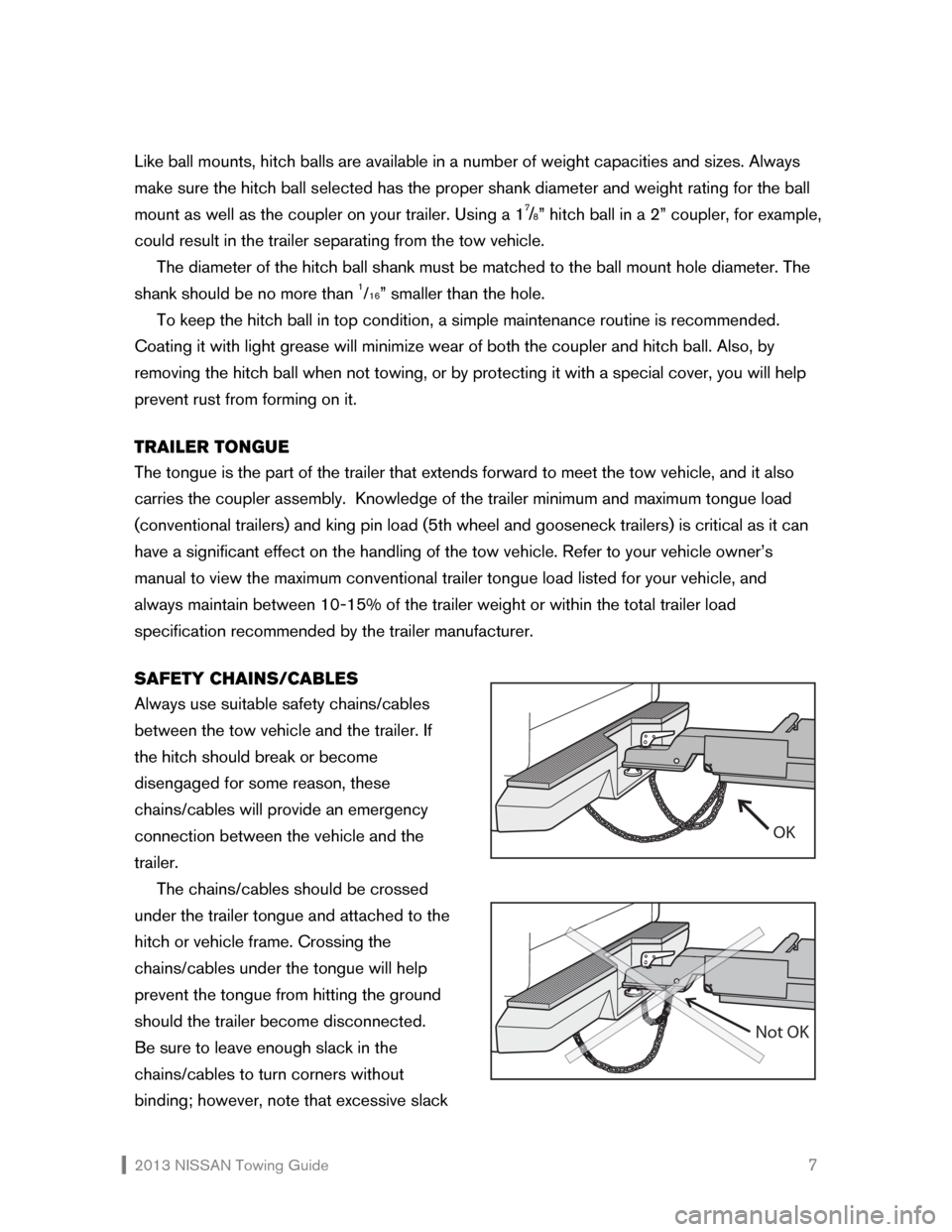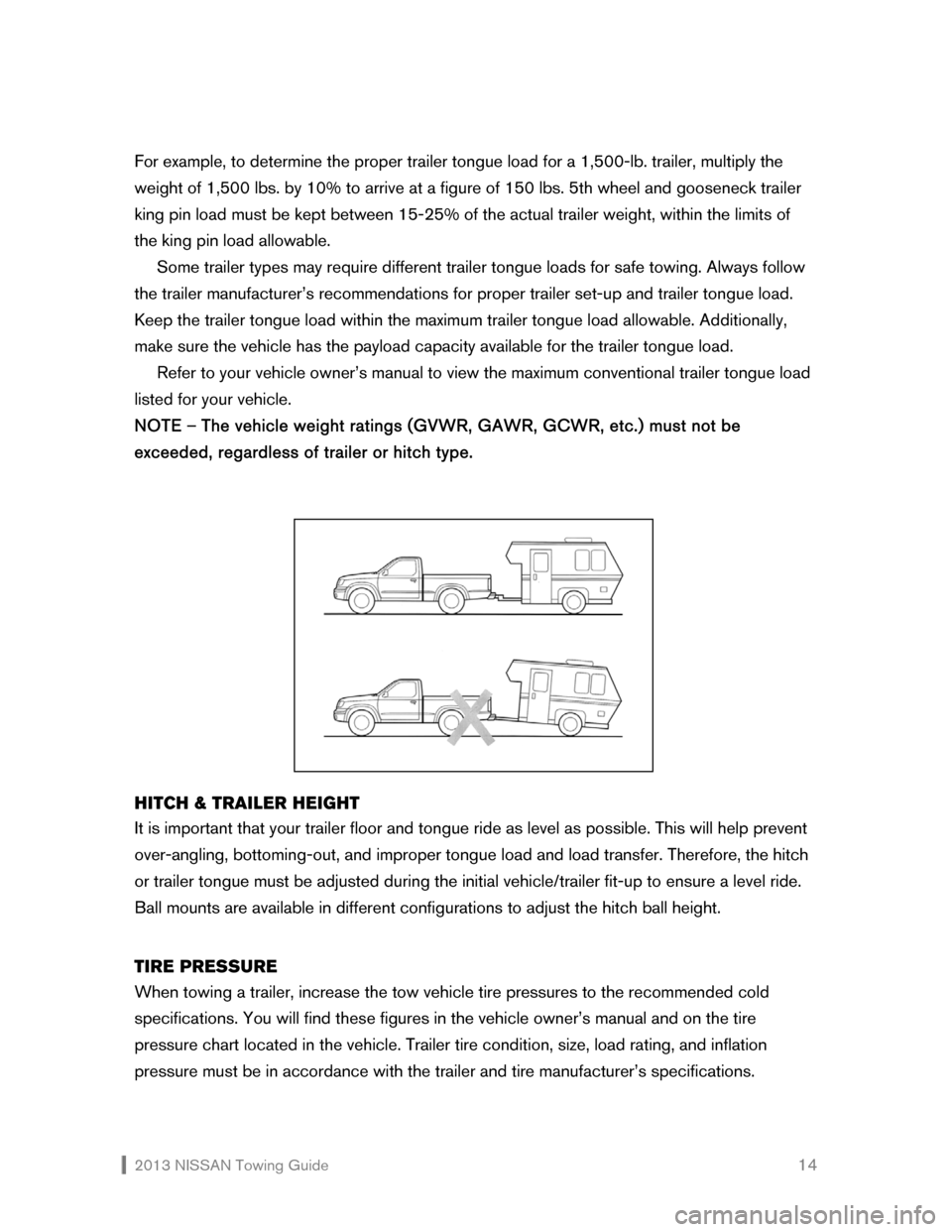wheel size NISSAN CUBE 2013 3.G Towing Guide
[x] Cancel search | Manufacturer: NISSAN, Model Year: 2013, Model line: CUBE, Model: NISSAN CUBE 2013 3.GPages: 27, PDF Size: 0.49 MB
Page 7 of 27

2013 NISSAN Towing Guide 6 5th Wheel or Gooseneck Hitch –
Mounted in the bed of a pick-up and
designed for heavy-duty applications,
these types of hitches are not available
from NISSAN but can be purchased from
a professional supplier of towing
equipment.*
A 5th wheel or gooseneck hitch is
usually installed and adjusted to meet the
requirements of a particular trailer, but two
basic rules hold true in every case. First,
the hitch should be mounted a minimum
2 inches forward of the rear axle centerline.
Second, it should be securely attached
directly to the truck frame. This installation
should be done by professionals only, as it
is very important to mount the hitch
correctly to distribute the king pin load for
the proper load carrying and sway control
performance.
BALL MOUNT
A ball mount (also known as a drawbar) is a bar that holds a hitch ball and is inserted into a
receiver-type hitch. Ball mounts come in a number of weight capacities (3,500 lbs., 5,000 lbs.,
etc.) and sizes (1
1/4”, 2”, etc.), and can be
weight-distributing or non-weight-distributing.
HITCH BALL
A hitch ball is bolted through a ball mount or
a hitch hole in the tow vehicle’s rear bumper.
The coupler on the trailer tongue attaches
over the hitch ball.
* At this time, Titan is the only NISSAN vehicle
approved for 5th wheel and gooseneck trailer towing. See your vehicle owner’s manual for details.
5th Wheel Hitch
Gooseneck Hitch
Hitch
Mount BallBall
Page 8 of 27

2013 NISSAN Towing Guide 7 Like ball mounts, hitch balls are available in a number of weight capacities and sizes. Always
make sure the hitch ball selected has the proper shank diameter and weight rating for the ball
mount as well as the coupler on your trailer. Using a 1
7/8” hitch ball in a 2” coupler, for example,
could result in the trailer separating from the tow vehicle.
The diameter of the hitch ball shank must be matched to the ball mount hole diameter. The
shank should be no more than
1/16” smaller than the hole.
To keep the hitch ball in top condition, a simple maintenance routine is recommended.
Coating it with light grease will minimize wear of both the coupler and hitch ball. Also, by
removing the hitch ball when not towing, or by protecting it with a special cover, you will help
prevent rust from forming on it.
TRAILER TONGUE
The tongue is the part of the trailer that extends forward to meet the tow vehicle, and it also
carries the coupler assembly. Knowledge of the trailer minimum and maximum tongue load
(conventional trailers) and king pin load (5th wheel and gooseneck trailers) is critical as it can
have a significant effect on the handling of the tow vehicle. Refer to your vehicle owner’s
manual to view the maximum conventional trailer tongue load listed for your vehicle, and
always maintain between 10-15% of the trailer weight or within the total trailer load
specification recommended by the trailer manufacturer.
SAFETY CHAINS/CABLES
Always use suitable safety chains/cables
between the tow vehicle and the trailer. If
the hitch should break or become
disengaged for some reason, these
chains/cables will provide an emergency
connection between the vehicle and the
trailer.
The chains/cables should be crossed
under the trailer tongue and attached to the
hitch or vehicle frame. Crossing the
chains/cables under the tongue will help
prevent the tongue from hitting the ground
should the trailer become disconnected.
Be sure to leave enough slack in the
chains/cables to turn corners without
binding; however, note that excessive slack
Not OK
OK
Page 15 of 27

2013 NISSAN Towing Guide 14 For example, to determine the proper trailer tongue load for a 1,500-lb. trailer, multiply the
weight of 1,500 lbs. by 10% to arrive at a figure of 150 lbs. 5th wheel and gooseneck trailer
king pin load must be kept between 15-25% of the actual trailer weight, within the limits of
the king pin load allowable.
Some trailer types may require different trailer tongue loads for safe towing. Always follow
the trailer manufacturer’s recommendations for proper trailer set-up and trailer tongue load.
Keep the trailer tongue load within the maximum trailer tongue load allowable. Additionally,
make sure the vehicle has the payload capacity available for the trailer tongue load.
Refer to your vehicle owner’s manual to view the maximum conventional trailer tongue load
listed for your vehicle.
NOTE – The vehicle weight ratings (GVWR, GAWR, GCWR, etc.) must not be
exceeded, regardless of trailer or hitch type.
HITCH & TRAILER HEIGHT
It is important that your trailer floor and tongue ride as level as possible. This will help prevent
over-angling, bottoming-out, and improper tongue load and load transfer. Therefore, the hitch
or trailer tongue must be adjusted during the initial vehicle/trailer fit-up to ensure a level ride.
Ball mounts are available in different configurations to adjust the hitch ball height.
TIRE PRESSURE
When towing a trailer, increase the tow vehicle tire pressures to the recommended cold
specifications. You will find these figures in the vehicle owner’s manual and on the tire
pressure chart located in the vehicle. Trailer tire condition, size, load rating, and inflation
pressure must be in accordance with the trailer and tire manufacturer’s specifications.